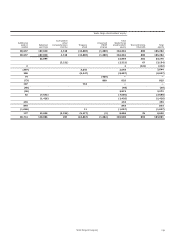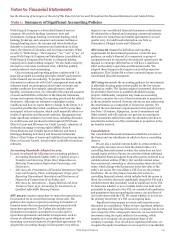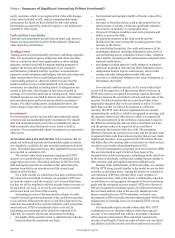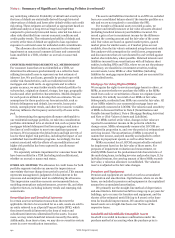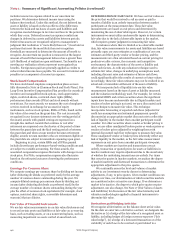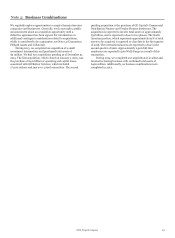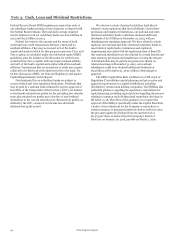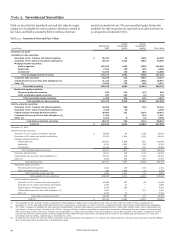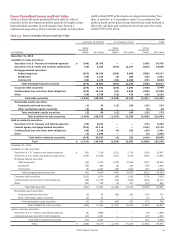Wells Fargo 2015 Annual Report Download - page 150
Download and view the complete annual report
Please find page 150 of the 2015 Wells Fargo annual report below. You can navigate through the pages in the report by either clicking on the pages listed below, or by using the keyword search tool below to find specific information within the annual report.Note 1: Summary of Significant Accounting Policies (continued)
includes income tax expense related to our uncertain tax
positions. We determine deferred income taxes using the
balance sheet method. Under this method, the net deferred tax
asset or liability is based on the tax effects of the differences
between the book and tax bases of assets and liabilities and
recognizes enacted changes in tax rates and laws in the period in
which they occur. Deferred income tax expense results from
changes in deferred tax assets and liabilities between periods.
Deferred tax assets are recognized subject to management's
judgment that realization is “more likely than not.” Uncertain tax
positions that meet the more likely than not recognition
threshold are measured to determine the amount of benefit to
recognize. An uncertain tax position is measured at the largest
amount of benefit that management believes has a greater than
50% likelihood of realization upon settlement. Tax benefits not
meeting our realization criteria represent unrecognized tax
benefits. Foreign taxes paid are generally applied as credits to
reduce federal income taxes payable. We account for interest and
penalties as a component of income tax expense.
Stock-Based Compensation
We have stock-based employee compensation plans as more
fully discussed in Note 19 (Common Stock and Stock Plans). Our
Long-Term Incentive Compensation Plan provides for awards of
incentive and nonqualified stock options, stock appreciation
rights, restricted shares, restricted share rights (RSRs),
performance share awards (PSAs) and stock awards without
restrictions. For most awards, we measure the cost of employee
services received in exchange for an award of equity
instruments, such as stock options, RSRs or PSAs, based on the
fair value of the award on the grant date. The cost is normally
recognized in our income statement over the vesting period of
the award; awards with graded vesting are expensed on a
straight-line method. Awards that continue to vest after
retirement are expensed over the shorter of the period of time
between the grant date and the final vesting period or between
the grant date and when a team member becomes retirement
eligible; awards to team members who are retirement eligible at
the grant date are subject to immediate expensing upon grant.
Beginning in 2013, certain RSRs and all PSAs granted
include discretionary performance-based vesting conditions and
are subject to variable accounting. For these awards, the
associated compensation expense fluctuates with changes in our
stock price. For PSAs, compensation expense also fluctuates
based on the estimated outcome of meeting the performance
conditions.
Earnings Per Common Share
We compute earnings per common share by dividing net income
(after deducting dividends on preferred stock) by the average
number of common shares outstanding during the year. We
compute diluted earnings per common share by dividing net
income (after deducting dividends on preferred stock) by the
average number of common shares outstanding during the year
plus the effect of common stock equivalents (for example, stock
options, restricted share rights, convertible debentures and
warrants) that are dilutive.
Fair Value of Financial Instruments
We use fair value measurements in our fair value disclosures and
to record certain assets and liabilities at fair value on a recurring
basis, such as trading assets, or on a nonrecurring basis, such as
measuring impairment on assets carried at amortized cost.
DETERMINATION OF FAIR VALUE We base our fair values on
the price that would be received to sell an asset or paid to
transfer a liability in an orderly transaction between market
participants at the measurement date. These fair value
measurements are based on exit prices and determined by
maximizing the use of observable inputs. However, for certain
instruments we must utilize unobservable inputs in determining
fair value due to the lack of observable inputs in the market,
which requires greater judgment in measuring fair value.
In instances where there is limited or no observable market
data, fair value measurements for assets and liabilities are based
primarily upon our own estimates or combination of our own
estimates and third-party vendor or broker pricing, and the
measurements are often calculated based on current pricing for
products we offer or issue, the economic and competitive
environment, the characteristics of the asset or liability and
other such factors. As with any valuation technique used to
estimate fair value, changes in underlying assumptions used,
including discount rates and estimates of future cash flows,
could significantly affect the results of current or future values.
Accordingly, these fair value estimates may not be realized in an
actual sale or immediate settlement of the asset or liability.
We incorporate lack of liquidity into our fair value
measurement based on the type of asset or liability measured
and the valuation methodology used. For example, for certain
residential MHFS and certain securities where the significant
inputs have become unobservable due to illiquid markets and
vendor or broker pricing is not used, we use a discounted cash
flow technique to measure fair value. This technique
incorporates forecasting of expected cash flows (adjusted for
credit loss assumptions and estimated prepayment speeds)
discounted at an appropriate market discount rate to reflect the
lack of liquidity in the market that a market participant would
consider. For other securities where vendor or broker pricing is
used, we use either unadjusted broker quotes or vendor prices or
vendor or broker prices adjusted by weighting them with
internal discounted cash flow techniques to measure fair value.
These unadjusted vendor or broker prices inherently reflect any
lack of liquidity in the market, as the fair value measurement
represents an exit price from a market participant viewpoint.
Where markets are inactive and transactions are not
orderly, transaction or quoted prices for assets or liabilities in
inactive markets may require adjustment due to the uncertainty
of whether the underlying transactions are orderly. For items
that use price quotes in inactive markets, we analyze the degree
of market inactivity and distressed transactions to determine the
appropriate adjustment to the price quotes.
We continually assess the level and volume of market
activity in our investment security classes in determining
adjustments, if any, to price quotes. Given market conditions can
change over time, our determination of which securities markets
are considered active or inactive can change. If we determine a
market to be inactive, the degree to which price quotes require
adjustment, can also change. See Note 17 (Fair Values of Assets
and Liabilities) for discussion of the fair value hierarchy and
valuation methodologies applied to financial instruments to
determine fair value.
Derivatives and Hedging Activities
We recognize all derivatives on the balance sheet at fair value.
On the date we enter into a derivative contract, we designate the
derivative as (1) a hedge of the fair value of a recognized asset or
liability, including hedges of foreign currency exposure (“fair
value hedge”), (2) a hedge of a forecasted transaction or of the
variability of cash flows to be received or paid related to a
Wells Fargo & Company
148



